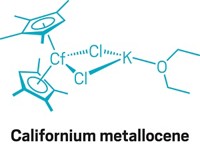Advertisement
Grab your lab coat. Let's get started
Welcome!
Welcome!
Create an account below to get 6 C&EN articles per month, receive newsletters and more - all free.
It seems this is your first time logging in online. Please enter the following information to continue.
As an ACS member you automatically get access to this site. All we need is few more details to create your reading experience.
Not you? Sign in with a different account.
Not you? Sign in with a different account.
ERROR 1
ERROR 1
ERROR 2
ERROR 2
ERROR 2
ERROR 2
ERROR 2
Password and Confirm password must match.
If you have an ACS member number, please enter it here so we can link this account to your membership. (optional)
ERROR 2
ACS values your privacy. By submitting your information, you are gaining access to C&EN and subscribing to our weekly newsletter. We use the information you provide to make your reading experience better, and we will never sell your data to third party members.
Physical Chemistry
'Quintuple' Bond Makes Its Debut
First stable molecule with fivefold metal-metal bonding is synthesized
by Stephen K. Ritter
September 26, 2005
| A version of this story appeared in
Volume 83, Issue 39

MULTIPLE BONDING
F. Albert Cotton and his coworkers at Texas A&M University surprised chemists in 1964 with evidence that the [Re2Cl8]2­ ion contained the first known multiple bond between two metal atoms. Not only was it a multiple bond, it was an unprecedented quadruple bond. Cotton convinced the world that he was right, and inorganic chemistry hasn't been the same since.
Now, Philip P. Power at the University of California, Davis, and his coworkers report evidence for the first "quintuple" bond between two metal atoms in the dichromium complex, RCrCrR, where R is a bulky terphenyl ligand (Science, published online Sept. 22, dx.doi.org/10.1126/science.1116789). The chromium dimer exists as air- and moisture-sensitive dark red crystals that are stable up to 200 °C.
Power and his coworkers believe that the two chromium(I) atoms, which have a 3d5 electron configuration, share five electron pairs in five bonding molecular orbitals. Power is cautious about using the word "quintuple" to describe the bonding in the new molecule, preferring to call it "fivefold bonding" because the actual bond order is likely less than five.
This fivefold bond isn't as unexpected as Cotton's first quadruple bond some 40 years ago, but it still has chemists abuzz.
Characterization of fivefold bonding in a stable compound "is an empirical landmark in the evolution of our understanding of metal-metal bonding in particular and bonding across the periodic table in general," note Frank A. Weinhold and Clark R. Landis of the University of Wisconsin, Madison. Weinhold and Landis have conducted extensive computational studies of transition-metal multiple bonding, and they agree that the Power group's structural, magnetic, and spectroscopic data, supported by computational studies, "are consistent with the formulation of a quintuple bond."
"This new compound fills a hole in our understanding of the bonding between transition-metal atoms," adds Björn O. Roos of Lund University, in Sweden, a theorist who has investigated multiple bonding in transition metals and actinides. "The compound is certainly worthy of a more profound theoretical study."
There are now thousands of examples of quadruple-bonded transition-metal compounds, including chromium(II) compounds with quadruple bonds, Cotton tells C&EN. The formulation of quadruple bonds in terms of the overlap of orbitals is clear, he says. But to consider a quintuple or sextuple bond "always entails some amount of heuristic argument."
In theory, diatomic transition-metal species can form up to six bonds between their valence shell s and d orbitals. A few sextuple-bonded compounds have been trapped at low temperature and observed spectroscopically, but they are unlikely to be isolated as stable compounds at room temperature.
If ligands are used to stabilize the multiply bonded metal atoms, the number of valence orbitals available for multiple bonding is reduced. For quintuple bonds, each metal could have only one ligand, as is the case in the chromium dimer.
Power's group is known for its synthesis of compounds containing multiple bonds between heavier group 14 elements, such as germanium-germanium triple bonds. Key to the group's success has been designing bulky substituents that stabilize molecules with atoms of low coordination numbers, such as the 2,6-[(2,6-diisopropyl)phenyl]phenyl group used with the chromium dimer.
The chromium dimer "is just a start," Power says, and may not be as important as what could result from the finding. "Hopefully, it will only be the forerunner of other quintuple bonds."
"I look forward to seeing how this story comes out as further experiments are done," Cotton adds. "This is beautiful and fascinating chemistry."






Join the conversation
Contact the reporter
Submit a Letter to the Editor for publication
Engage with us on Twitter